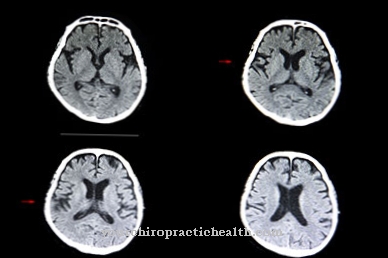In the Spondylarthritis it is an inflammatory rheumatic disease that particularly affects the vertebral joints. It occurs mainly in men and manifests itself as back pain and a stiffening of the spine. The disease is chronic and cannot be completely cured.
What is Spondylarthritis?

© beermedia - stock.adobe.com
Under the name Spondylarthritis Doctors understand an inflammatory disease that primarily affects the vertebral joints.It occurs as part of rheumatic diseases and can affect both the spine itself and other joints in the person's body.
There are different types of the disease. It manifests itself through symptoms such as deep-seated back pain, joint stiffness, swelling of the finger or toe joints and, in the later stage, through a rounded back caused by a stiffening of the spine.
70% of the patients who suffer from spondylarthritis are men between the ages of 20 and 40. Spondylarthritis is a chronic disease that is quite treatable but not curable.
causes
The causes of the occurrence of a Spondylarthritis could not yet be clearly clarified. Scientists suspect, however, that the disease may have a genetic predisposition.
Research has shown that approximately 90% of all patients with spondylarthritis have a malformation of the HLA-B27 gene. This is a protein complex that is found in almost all human cells. If this gene is mutated, it can lead to certain autoimmune diseases.
The development of spondylarthritis is also attributed to this genetic factor. It is also noticeable that the occurrence of the disease often accumulates in families. Multiple cases of diagnosed spondylarthritis in the family can therefore mean that even now asymptomatic offspring will later suffer from the disease.
Typical symptoms & signs
- Back pain
- Lower back pain
- joint stiffness in the morning
- Heel pain
- Rounded back with stiffening of the spine
Diagnosis & course
A Spondylarthritis can be diagnosed in different ways by the treating physician. In the early stages, imaging procedures such as x-ray examinations often do not provide any findings.
In the later course, however, bony outgrowths are visible on the affected joints. Patients usually experience pain when tapping the spine. The following criteria in particular were introduced for a reliable diagnosis of spondylarthritis: persistent back pain for more than three months, restricted mobility in the lumbar spine and a reduced breathing width (chest circumference when breathing in and out deeply).
If spondylarthritis remains untreated, it will lead to more severe pain in the further course, which is associated with significant restrictions on movement. This can lead to incapacity for work and a decrease in quality of life in general.
Complications
First and foremost, those affected by spondylarthritis suffer from severe pain. These occur mainly in the back or the cross and have a very negative effect on the quality of life of the person concerned. In many cases, the pain also spreads to the groin or neck.
If the pain occurs during the night, it leads to sleep problems and thus irritability of the patient and possibly depression. Restrictions in movement and in everyday life can also occur. People also experience difficulty walking due to pain in the heel.
If the spondylarthritis is left untreated, the pain can worsen, making the person unable to work and further reducing their quality of life. The pain in spondylarthritis can primarily be treated with pain relievers. There are no complications.
However, prolonged use of pain relievers can also damage the stomach. Furthermore, the patients are dependent on various exercises and therapies. It may also be necessary to attach an artificial joint in order to limit the symptoms permanently. Spondylarthritis does not usually reduce the patient's life expectancy.
When should you go to the doctor?
Spondylarthritis usually always requires medical treatment from a doctor. Since this disease cannot heal itself and the symptoms usually worsen if left untreated, a doctor should be consulted very early on. A complete cure of the spondylarthritis is not possible, although an early start of therapy can nevertheless have a positive effect on the further course of the spondylarthritis.
A doctor should be consulted if the person concerned suffers from very severe pain in the back or lower back. Typically, this pain occurs primarily in the morning after you wake up. Heel pain can also indicate the disease and should be examined by a doctor if it occurs over a long period of time and does not go away on its own. Furthermore, many sufferers also suffer from restrictions in their movement and thus in their everyday life.
If you have spondylarthritis, you can see an orthopedic surgeon or a general practitioner. The treatment itself depends on the exact complaints and their severity. As a rule, the patient's life expectancy is not restricted by this disease.
Treatment & Therapy
Became a Spondylarthritis When diagnosed, pain relief usually comes first in the following treatment. In most cases, this is done with the help of pain relievers, anti-inflammatory drugs or so-called muscle relaxants (drugs that relax the muscles).
Cold applications and, if necessary, electrotherapy can also help relieve the person affected. In addition, physiotherapy treatment should always take place. This can help to maintain the patient's mobility over a longer period of time. The ability to work can also last longer than without appropriate treatment.
Both drug and physiotherapy therapy for spondylarthritis must be permanent in order to slow the progression of the disease as much as possible. If there has already been permanent swelling and hardening or wear and tear of the joints, a surgical procedure must take place, for example to introduce an artificial joint replacement. Spondylarthritis is a chronic disease that is usually quite slow but cannot be cured.
prevention
Since the Spondylarthritis If it is a genetically determined disease, prevention in the strict sense is not possible. However, people with a family history should regularly consult a doctor in order to initiate rapid treatment of the first symptoms if necessary. The same applies if symptoms arise that could be caused by spondylarthritis. The earlier the disease is recognized and treated, the slower it will progress, which can significantly increase the quality of life of those affected.
Aftercare
Since spondylarthritis cannot heal on its own, the person affected should consult a doctor at the first signs and symptoms of this disease. In many cases, the direct follow-up measures are significantly limited, so that an early diagnosis must be made first and foremost. A complete cure is usually not possible.
Some of the symptoms can be relieved relatively well with the help of physiotherapy or physiotherapy. The affected person can also repeat some of the exercises in their own home and thus accelerate the healing process. In addition, taking various medications is often very important. The person affected should always ensure that they are taken regularly and that the dosage of the drug is correct.
Consult a doctor first in the event of side effects, ambiguities or questions. The help of one's own family is often very important. Compassionate conversations can prevent depression and other mental upsets. Spondylarthritis does not usually reduce the life expectancy of those affected.
You can do that yourself
With spondylarthitis, those affected should avoid being overweight if possible so that the joints are not put under additional strain. While there is no specific diet for treating this condition, there are certain foods that can help relieve symptoms. In general, a diet that helps patients to have a positive influence on the chronic inflammatory processes in the body is recommended.
Fatty acids and high-quality fats are particularly important for patients with spondylarthritis. The omega-6 fatty acid "arachidonic acid" is an important starting point for the production of inflammation-promoting substances in the body of those affected. Arachidonic acid is mainly found in animal foods. That is why patients should only consume very low amounts of fatty sausage and meat. The rule of thumb here is that sick people should not eat more than a maximum of two meat meals per week. In addition, a limit of two eggs per week is recommended because eggs also contain a high proportion of omega-6 fatty acids.
In general, the diet should be very varied and rich in vegetable fats and fiber. Because the body needs a particularly large number of minerals and vitamins to combat inflammation. It is also advisable to integrate light movement into everyday life. This helps to maintain your own mobility and to reduce pain.



.jpg)
.jpg)

.jpg)





.jpg)



.jpg)










.jpg)
